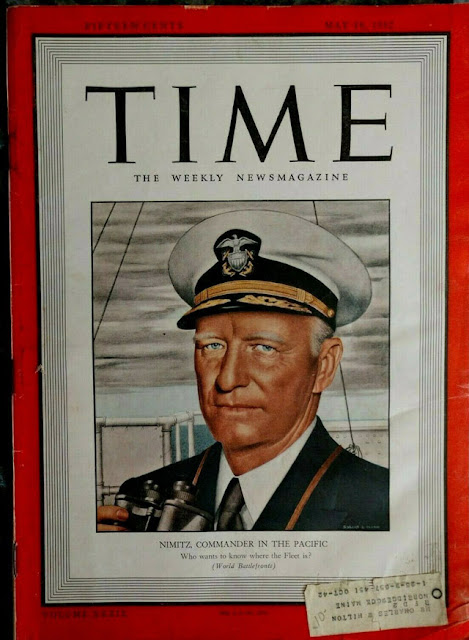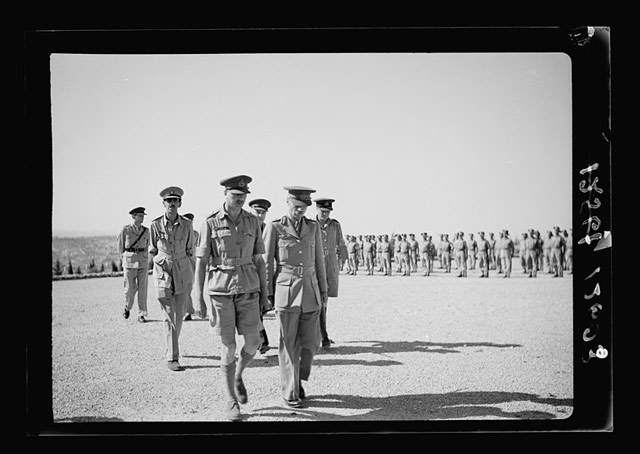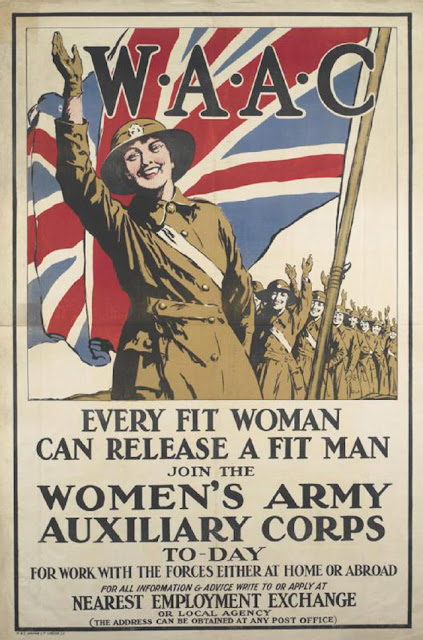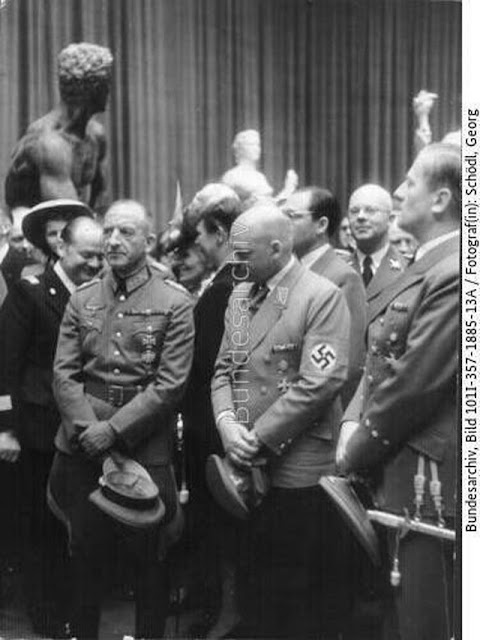Friday 15 May 1942
 |
| Luftwaffe pilot Hermann Graf (right), Staffelkapitan 9./JG 52, stands before his Messerschmitt Bf-109F-4 at the Kharkov-Rogan airfield after achieving his 100th victory, May 15, 1942. |
Battle of the Pacific: A Japanese Kawanishi reconnaissance aircraft based at Tulagi sights Admiral "Bull" Halsey's Task Force 16 on 15 May 1942. The task force, which includes aircraft carriers USS Enterprise and Hornet, is 445 nautical miles (512 miles, 824 km) east of the Solomon Islands. The presence of the two US carriers convinces Japanese Vice Admiral Shigeyoshi Inoue to cancel Operation RY, the planned invasion of Nauru and Ocean Island. This is exactly what Admiral Chester Nimitz intended, as he wants Halsey's force to return to Pearl Harbor for the looming battle at Midway without being forced into any more actions.
The two Japanese carriers that survived the Battle of the Coral Sea, Zuikaku and Shōkaku, are proceeding back to Japan and cannot be ready for the Midway battle due to the damage they have sustained. Shōkaku almost sinks in foul weather, while Zuikaku stops today at the base at Truk before continuing on to Japan. The US Navy knows their general routes and stations eight submarines in position to intercept the carriers, but no sightings are made.
US Fifth Air Force sends B-25 and B-26 bombers to raid Lae and the Japanese seaplane base at Deboyne. They cause damage at Lae, but the Japanese already have evacuated Deboyne.
 |
| Time, 15 May 1942: "Nimitz, Commander in the Pacific." |
Battle of the Indian Ocean: Retreating British troops in Burma are consolidating on the western border. Today, they reach Assam in northeastern India. Other Allied troops are assembling at Tamu to the south. The Japanese continue to occupy Burma and have no plans at this time to invade India.
In the Indian Ocean, the ships of Ko ("A") Detachment that is to attack Royal Navy ships at Madagascar and other points refuel at sea from supply ships Aikoku and Hokoku Maru. This force includes submarines I-10, I-16. I-18, I-20, I-30, I-27, and I-28, most converted to carry Type A Kai 1 midget submarines. I-10 and I-30 carry floatplanes instead. This is more an expedition of opportunity than a well-planned operation.
US submarine USS Tuna torpedoes and sinks 805-ton Japanese freighter Toyohara Maru 65 miles off Sohuksando, Korea. There are 21 deaths.
 |
| Inspection of Australian Guard of Honour at Government House by the Duke of Gloucester on May 15, 1942. The Duke and party are leaving (Matson Collection, Library of Congress #matpc.21541). |
Eastern Front: The Red Army renews its struggling offensive in the northern pincer above Kharkov, but the Wehrmacht now has had time to regain its footing. German fortresses such as at Ternovaya continue to hold out due to a lack of Soviet heavy artillery. The Soviets advance only five kilometers during the day against stiffening German resistance. General Franz Halder at Fuhrer Headquarters writes that "the main thrust of the enemy offensive in the direction of Kharkov appears to be checked."
South of Kharkov, the situation is a little more dangerous. General Halder notes that "Here we may yet witness further enemy advances." However, while the Red Army has openings to the west and south, there are no strategic objectives within reach in those directions. The Germans are guarding Kharkov itself fiercely and, for the time being, are content to let the Soviet troops under General Semyon Timoshenko wander about in the undeveloped country south of the city where they can do little damage. General Ewald von Kleist is preparing a counteroffensive with his First Panzer Army to close off the Soviets' supply corridor, but that will take a couple of days to assemble.
In Crimea, the German 11th Army take the key port of Kerch. This eliminates the main Soviet escape route to the Taman peninsula on the mainland - which they cannot use anyway because Stalin has not authorized a general retreat - and decides the campaign. The Soviets now only hold Sevastopol on Crimea, to which General Erich von Manstein now can turn his full attention.
 |
| Photo in Vogue by Toni Frissell (Antoinette Frissell Bacon), 15 May 1942. |
At Fuhrer Headquarters, General Halder writes that "The Kerch offensive may be considered closed. Town and harbor are in our hands." However, there is still Soviet resistance south of Kerch. These holdouts have no chance of escaping the POW camps for long, but they still take almost a week to subdue. The Red Air Force is losing planes at a rate of 10-1 to the Luftwaffe, and infantry losses are at an even greater disadvantage to the Soviets.
European Air Operations: Operations remain light. Aside from coastal sweeps, the RAF only sends 50 bombers to lay mines in the Western Baltic. Two Hampdens and two Wellingtons fail to return.
A Bf 109F of 9./JG 11 crash lands in a field near Tarm, Denmark. With great efficiency, the plane is quickly prepared for transport by removing the wings and returned to a Luftwaffe base for its return to service.
 |
| Women may volunteer for the Women’s Auxiliary Army Corps as of 15 May 1942. |
Battle of the Atlantic: The Luftwaffe attacks Murmansk and scores a direct hit on US freighter Yaka. While there are no casualties of the 49 men on board, the ship must be beached to prevent it from sinking.
U-156 (Kptlt. Werner Hartenstein), on its third patrol out of Lorient, torpedoes and sinks 4382-ton Yugoslavian freighter Kupa in the Atlantic northeast of Barbados. There are two dead and 68 survivors.
U-156 also torpedoes and sinks 4301-ton Norwegian freighter Siljestad northeast of Barbados. There are two dead and 31 survivors.
The Lockheed Hudson bombers of RAF Nos. 320 and 407 Squadron make a successful anti-shipping sweep off the French coast. The RAF bombs and sinks 713-ton German minesweepers M 26 and M 256 off Cap de La Hogue, France. M 256 is later raised and returned to service. The bombers also sink German 464-ton vorpostenboot V 2002 Madeleine Louise off Terschelling, Netherlands, along with 6698-ton Norwegian freighter Selje. There are 14 deaths of the 62 people on board Selje.
British 6677-ton freighter Soudan, traveling with Convoy WS 15, hits a mine and sinks near Cape Agulhas, South Africa. There is one death.
British light cruiser HMS Trinidad, badly damaged in the Barents Sea by Luftwaffe attacks, is scuttled. There are 62 dead.
Battle of the Mediterranean: Winston Churchill sends Malta commander Lord Gort a telegram appointing him as "Supreme Commander of the Fighting Services and Civil Administration in Malta." Rome radio today announces that Gort was wounded by a bomb splinter, but it is unclear if this is true as there has been no official announcement.
Costa Rican/Hungary/Romania Relations: Costa Rica breaks diplomatic relations with Romania and Hungary.
US Military: Insignia on US military aircraft are changed by eliminating the red disc in the center of the star. All red and white rudder stripes are removed from navy aircraft. In addition, US Army Air Force pursuit units are renamed fighter units today.
Legislation signed by President Roosevelt on 14 May 1942 goes into effect today creating the Women’s Army Auxiliary Corps (WAAC). The service is voluntary and evolves into the Women’s Army Corps (WAC) in 1943.
The War Department leases nearly eight and a half acres of Fort McHenry for the Coast Guard to use as a fire control and port security training facility. There will be a five or six-week course, after which members will be stationed along the coast at key facilities and for training others.
 |
| The opening of an Arno Breker exhibition in Paris, France, on 15 May 1942. Breker is a popular sculptor in the Third Reich and, among other things, accompanied Adolf Hitler during his tour of Paris. At the center is Gauleiter Fritz Sauckel (Schodl, Georg, Federal Archive Image 101I-357-1885-13A). |
Holocaust: The Slovak parliament issues Decree 68/1942. This retroactively legalizes the deportation of Jews, legalizes the removal of their citizenship, and regulates exemptions for such actions. An agreement is reached with the Reich wherein the Slovaks will pay 500 Reichsmarks per individual deported to Germany and an additional train fare to the Reichsbahn to defray expenses. In return, Germany agrees to never return the deported individuals and Slovakia is allowed to keep all confiscated property.
Within parliament, there is no opposition to this legislation and general agreement about its terms. The official Catholic representative, Ján Vojtaššák, only asks for special consideration for Jews who have converted to Christianity. Trains carrying victims have been running to the camps at Auschwitz and Majdanek since 25 March 1942.
American Homefront: Mandatory gasoline rationing goes into effect for non-essential vehicles in the first seventeen states. Usage is limited to three gallons per week. Eight million motorists register for ration cards. The average motorist receives an "A" classification, while business owners, doctors, truckers, and those with necessary transportation jobs are issued either “B,” “C,” “T,” or “X” stickers that would ensure they received the proper amount of gas for their duties. Rubber for tires also is being rationed. A national speed limit of 35 mph is imposed, called the Victory Speed. Even with rationing, long lines arise at the few gasoline stations that have supplies.
 |
| Vogue, 15 May 1942. |

No comments:
Post a Comment